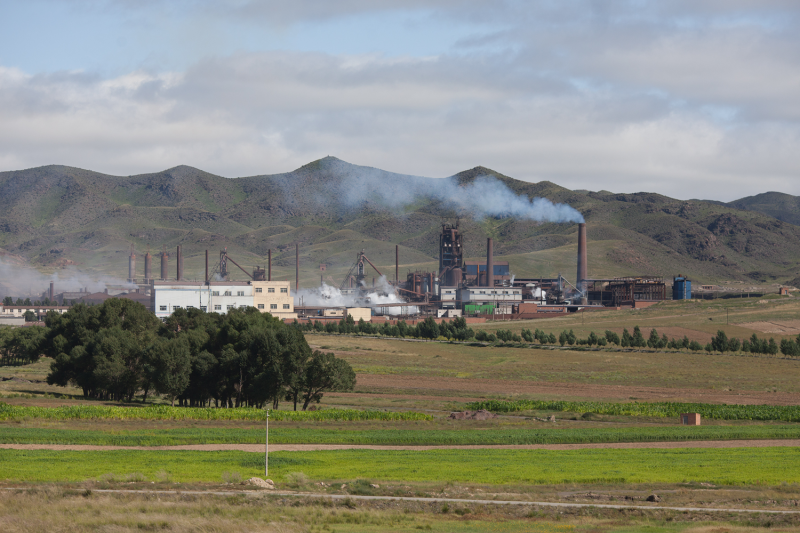Does Xi Have Trump’s Number?

Does Xi Have Trump’s Number?
China has come out ahead in recent dealmaking.
A rare-earth refinery north of the Inner Mongolian city of Baotou on Aug. 20, 2012. Ed Jones/AFP via Getty Images
The world breathed a sigh of relief on May 12 when, after negotiations in Geneva, the United States and China initially agreed to a 90-day pause in their trade war, halting sky-high reciprocal tariffs and other measures, such as China’s latest export controls on rare earths. Markets reacted positively, and businesses geared up to use the pause to ramp up trade of goods in both directions, in case the cease-fire wasn’t extended.
The goodwill lasted all of one day. The deal quickly hit a snag over the status of the seven rare earths (samarium, gadolinium, terbium, dysprosium, lutetium, scandium, and yttrium), but it’s not clear why—or how significant this is. Some may read this as another example of the tussle between the two powers, with things likely to settle down after the recent meeting in London, in which China agreed to a six-month pause on any rare-earth limitations. U.S. President Donald Trump said the deal was “done,” while Chinese Vice Commerce Minister Li Chenggang said the two sides had, “in principle, reached a framework for implementing the consensus.”
The world breathed a sigh of relief on May 12 when, after negotiations in Geneva, the United States and China initially agreed to a 90-day pause in their trade war, halting sky-high reciprocal tariffs and other measures, such as China’s latest export controls on rare earths. Markets reacted positively, and businesses geared up to use the pause to ramp up trade of goods in both directions, in case the cease-fire wasn’t extended.
The goodwill lasted all of one day. The deal quickly hit a snag over the status of the seven rare earths (samarium, gadolinium, terbium, dysprosium, lutetium, scandium, and yttrium), but it’s not clear why—or how significant this is. Some may read this as another example of the tussle between the two powers, with things likely to settle down after the recent meeting in London, in which China agreed to a six-month pause on any rare-earth limitations. U.S. President Donald Trump said the deal was “done,” while Chinese Vice Commerce Minister Li Chenggang said the two sides had, “in principle, reached a framework for implementing the consensus.”
There is a strong case to make, however, that the dynamics of the relationship have dramatically shifted now that China has shown an unprecedented willingness to use its coercive toolkit. China may now have a much larger say in shaping patterns of escalation and de-escalation—and in whether Beijing and Washington are headed toward reconciliation or decoupling.
In the days after the Geneva announcement, based on reports from frustrated U.S. firms, the United States accused China of going back on its word and not permitting the resumption of rare-earth exports. Beijing responded that it was complying and that the only hang-up was cumbersome export approval procedures. It simultaneously complained that the United States had violated the “spirit of Geneva” when, on May 13, the U.S. Commerce Department’s Bureau of Industry and Security issued an advisory that use of Huawei’s Ascend 910 chip by anyone “anywhere in the world” could constitute a violation of U.S. export control rules and expose the user to “substantial criminal and administrative penalties.”
The Trump administration did not accept this countercharge, responding with even more forceful measures over the next two weeks, including putting export controls on U.S. commercial aviation equipment destined for China’s C919 narrow-body airliner, chemicals, and semiconductor software design tools. Moreover, the State Department announced that the United States would begin to “aggressively revoke” the visas of Chinese students who had ties to the Chinese Communist Party.
The prospect of a total collapse was only stemmed when Trump and Chinese President Xi Jinping spoke on June 5 and agreed to the London meeting. A statement from China’s Ministry of Foreign Affairs again asserted China had honored its commitments and that it was the United States that had acted unfairly: “The U.S. side should acknowledge the progress already made, and remove the negative measures taken against China.” Around this time, the U.S. Commerce Department modified the restrictions on the Huawei chip, quietly removing the phrase “anywhere in the world” from its guidance.
In the London talks that concluded on June 10, the two sides reached a “handshake deal.” According to CNBC, U.S. Commerce Secretary Howard Lutnick said Washington’s latest export controls “would be rolled back as Beijing approves rare earths exports.”
There are at least two potential ways to read what has happened over the past month. The narrowest, most prosaic view is that none of this is new. Neither side was trying to outright scuttle the deal but were testing the other to determine what they could get away with, which is par for the course in trade tiffs. China has regularly in the past tried to “renegotiate” agreements after they have been signed, from individual investment deals to the terms of its World Trade Organization (WTO) accession. (Who can forget China’s commitment in 2001 to join the Government Procurement Agreement “as soon as possible”?)
Similarly, the United States has previously said its plans to expand its high-tech de-risking efforts, such as the kinds of limits imposed on the Huawei Ascend chips, would continue without pause on a separate track from tariff talks. Each side’s measures sparking responses is unsurprising—and, given the slowdown in both economies, it is no wonder that cooler heads have prevailed for now.
But there is a second, more dramatic—and likely more plausible—interpretation: For the first time ever, China intentionally cut off its rare-earth exports to the United States in response to Trump’s declaration of trade war. And despite the Trump administration’s blustery response, the United States’ absolute dependence on raw and processed rare earths from China led it to completely back down to the status quo ante.
Granted, China has not been shy about throwing its economic weight around in the past. It has long traded access to its market for technology transfer. It has punished trading partners—among them, Australia, Japan, Lithuania, Norway, the Philippines, South Korea, and Taiwan—by blocking the exports of specific products to China. It has taken a whole variety of actions against U.S. firms, including blocking mergers and acquisitions and fining firms for violating its anti-monopoly law.
But this appears to be the first time China blocked export to the United States of a “chokepoint” product, which occurs when a monopolist denies export of a product that the importer desperately needs. China did take similar actions against Japan in the wake of maritime tensions in 2010, but Japan is a much weaker power than the United States, and China’s ban was undermined by domestic smugglers and abandoned after two months.
The potential costs of taking this action are high. The target could escalate, rather than backing down. It could reinforce the impression that China is willing to weaponize normal commerce to hurt adversaries, driving business away and pushing others together against China. With rare earths, where China has a monopoly on refinement but not extraction, it could speed up the push to build new facilities in the United States and elsewhere that can handle such minerals.
But the trade war seems to have been the perfect test for this strategy. Trump had clearly signaled through sky-high tariffs, a phalanx of nontariff barriers, and heated rhetoric that he was pursuing a scorched-earth trade strategy intended to intimidate everyone, including China, into making massive unilateral concessions. Yet, at the same time, the U.S. president has repeatedly backed down when faced with intense geopolitical or economic pushback, in a pattern Wall Street traders have dubbed “TACO” (Trump always chickens out).
The most important signal that Trump would relent under counterpressure was his shift on April 9 to reduce tariffs on everyone but China, followed by his repeated public statements suggesting that he wanted to talk with Xi. The right moment came when the Commerce Department issued its new guidance on Huawei chips right after the Geneva agreement. The hope appears to have been to use the pause in rare-earth exports to push the United States to back down from not only this action but deter it from taking other punitive steps in the future. One Chinese observer explained the logic to me with the saying “One punch can prevent a hundred punches.”
Policymakers and students of interdependence, and weaponized interdependence in particular, will be studying this case and its implications for a long time. They will debate whether this episode is more proof of the need for the United States to “de-risk” or “decouple” from China or if a different approach is needed to manage the challenges of complex interdependence with one’s rival.
There certainly are several worrying signs. The most immediate is that China, despite its claims that its system to manage rare-earth exports is designed to benefit everyone, has, in fact, successfully weaponized its monopoly on refinement of these vital minerals, holding 92 percent of global capacity, to force the United States to back down.
Some experts, writing before the current crisis, have optimistically argued that China can only use this threat once because the United States and others can build stockpiles and develop alternative sources. But the United States and others, despite having taken some steps, have largely frittered away the last 15 years, since the initial actions against Japan, and it will still be a decade or more before there is a serious dent in China’s monopoly.
To drive the point home, China has pledged to continue to provide rare earths to the United States for only six months. It may now feel emboldened to threaten restrictions on other items where it dominates, from antibiotics and active pharmaceutical ingredients to cobalt, tungsten, and auto parts. And can the world still be sure that China will not threaten to sell off its substantial holdings of U.S. Treasurys?
More broadly, the United States is no longer alone in shaping the trajectory of the trade war. China previously was only in a position to offer concessions to lower the temperature on tensions. Beijing now can turn the dial both up and down. This limits U.S. freedom of action not only on trade but potentially in other spheres as well, including possibly the Taiwan Strait.
Equally important, the United States can no longer lean on the larger principles of the rules-based multilateral trading order or its allies to push China to comply because it no longer supports either. It has abandoned the ideas of most-favored-nation status and national treatment in favor of a series of individual deals that privilege itself above all others, the system and allies be damned. In sum, the hard- and soft-power foundations of U.S. primacy have taken a huge hit.
There may be some silver linings around these darkening clouds. Although China’s ability to effectively weaponize rare earths (and potentially other strategically important products) has backfooted the United States, it may also create disincentives for the Trump administration to escalate without limit on tariffs or take other destabilizing steps that could create other crises, generate more pressure for fragmentation, and slow global growth.
It is uncomfortable that China, which itself has eroded the WTO’s authority with its oversized industrial policy machine, should receive credit for potentially creating a more stable balance of power, but this is not the first sign the world is upside down.
It may also lead to a more serious conversation about how to manage interdependence. While it is absolutely vital for the United States and its allies to mitigate their vulnerabilities, individually and as a group, the U.S. and Chinese economies are likely to be interconnected for a very long time. And so the U.S. and Chinese governments should begin an adult conversation about the rules of the road for the use and abuse of their respective coercive tools, including raw materials, advanced technologies, international financial payments, holdings of government bonds, telecommunication networks, and data security.
In the wake of the Cuban missile crisis, U.S. and Soviet policymakers and scientists agreed to norms and rules that have kept the world from nuclear war far longer than most would have confidently predicted. Although the forthcoming U.S.-China negotiations will likely focus on market access and short-term dealmaking, officials and experts from the United States, China, and others should take inspiration from their predecessors and at some point have a much more meaningful conversation about how to manage their relationship and promote stability, peace, and prosperity in the years and decades ahead.
Scott Kennedy is a senior advisor and trustee chair in Chinese business and economics at the Center for Strategic and International Studies.
Stories Readers Liked
Iran-Israel Conflict
Analysis and reporting

How the Israel-Iran War Might End
Scenarios include an Iranian defeat, an Israeli retreat—or an expanded regional conflict.




















Join the Conversation
Commenting is a benefit of a Foreign Policy subscription.
Subscribe
Subscribe
Already a subscriber?
.
View Comments
Join the Conversation
Join the conversation on this and other recent Foreign Policy articles when you subscribe now.
Subscribe
Subscribe
Not your account?
View Comments
Join the Conversation
Please follow our comment guidelines, stay on topic, and be civil, courteous, and respectful of others’ beliefs.
View Comments
Change your username |
Log out
Change your username:
CANCEL
Confirm your username to get started.
The default username below has been generated using the first name and last initial on your FP subscriber account. Usernames may be updated at any time and must not contain inappropriate or offensive language.